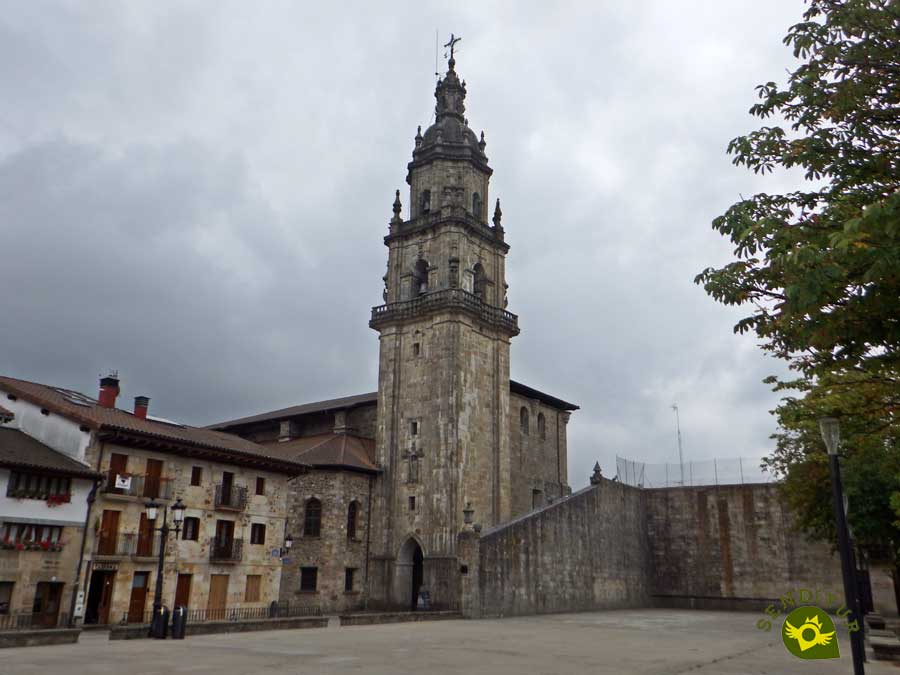Between the Gorbea Natural Park and the Urkiola Natural Park, between the Amboto and Gorbea massifs, in the province of Vizcaya-Bizkaia, within the Duranguesado region and on the south side of the Urquiola port, Otxandio was founded as a defensive town due to its strategic location. The first time its name is mentioned is in the document of the privileges that Sancho the Wise of Navarre granted to the Duranguesado in the 12th century. In the 13th century it received the Town Charter and the title of town, being one of the 14 towns that made up, together with the city of Orduña and Tierra Llana, the Lordship of Vizcaya, occupying the twentieth seat on the Boards of Gernika.

From the end of the 13th century Otxandio lived close to the flag fights, and between the 14th and 15th centuries it was the place from where the nobles of the lordship engaged in struggles for economic power between urban society and rural nobles. In the following centuries the town experienced war and economic conflicts, as well as a good metallurgical industrial hegemony until in the nineteenth century technological changes ended the economic boom of iron. The town also suffered the consequences of the Spanish Civil War in the twentieth century and years later, in the middle of that century, the industrial revival reactivated in the town its main economic activity, the transformation and metallurgical manufacture.

Around Otxandio's neuralgic and social centre, in the Nagusia square, the main square, are the most outstanding buildings of the town. The town hall, declared a national monument, is of baroque style built in the year 1742 in its main facade can be seen three coats of arms, the Bizkaia, Castilla de los Austrias and the municipality. The parish church of Santa Marina, built in the 16th century on top of a previous temple, was joined in the 18th century by the baroque bell tower. The bolatoki, the bowling alley, is a more than curious building from the year 1861, shelters on the ground floor and maintained by 12 classic columns, the bowling alley, which is currently an exhibition hall, and at the height of the square houses a large space, the pasealeku, where you can have fun, being covered and protected, the days of bad weather.

The fountain of Vulcano, dedicated to the god of fire and in homage to the importance of the forges in the historical past of the town. The house of culture, from the 19th century. Walking through its streets we will see houses with coats of arms and the building of what was the hospital, built in 1722 and now converted into a residence for the third age. A commemorative monument is erected in Andikona Square, as this place was unfortunately the scene of the first bombardment of civilians in Europe. Outside the village, in the middle of a beautiful beech forest is the hermitage of San Martín, a small Gothic temple built between the 15th and 16th centuries. The privileged environment of Otxandio gives many options for outdoor leisure, hiking, mountaineering, mountain biking ..., in addition to the Urrúnaga reservoir, where it is possible to practice various water activities such as rowing or fishing, we can also enjoy the route that borders it in the Biscayan part.

Otxandio-Ochandiano celebrates its patron saint festivities on 18 July in honour of Santa Marina. On June 11 is celebrated, in the district of Mekoleta, the feast is for San Bernabé
On the third Sunday in September, the "Basabisitta" is celebrated. It is a traditional act that commemorates the conflicts that Otxandio has been maintaining with Aramayona since the 18th century for the place known as "El Limitado". In this march, in which the atabalero marks the rhythm, a great number of neighbors participate together with the local authorities, it is a route in which the state of the milestones is checked and special marks are made in the trees to signalize the limits of the municipal term. Cod and wine sandwiches are distributed along the entire route.
The exploitation of iron ore in Vizcaya-Bizkaia is lost in the memory of history. Pliny already spoke of a mountain of iron on the coasts of the Cantabrian Sea, perhaps the mountains of Triano. The irons of Vizcaya-Bizkaia were so famous that even Shakespeare in his play "Hamlet" names the bilbaos, bilboes, which were special shackles used against the mutineering sailors. In the iron industry of Otxandio-Ochandiano different products were made, mainly nails and horseshoes, the famous " clavas of Otxandio-Ochandiano ".

In the town hall building, on the main façade there is a large sundial with a curious inscription "Dies nostra sicut umbra traseunt", "our days go by like a shadow".
MORE ROUTES AVAILABLE, DON'T MISS IT...
MORE PLACES AVAILABLE, DON'T MISS IT...
Otxandio is located on the road linking Legutio, on the N-240 between Vitoria and Bilbao, with Durango on the N-634 between Bilbao and San Sebastián.
Otxandio-Ochandiano has a Bizkaibus service that connects it with Bilbao, Galdakao, Bedia, Lemoa, Igorre, Dima or Ubide. The regular bus service also connects it with Vitoria-Gasteiz, Legutio, Mañaria, Izurtza or Durango.
The nearest train station to Otxandio-Ochandiano is in Urbina, Alava.
SENDITUR is not responsible for any variation in the information described, as well as for the misuse of its guides and recommends that everyone be responsible and prudent in carrying out the activity. Likewise, we invite you to document yourself with books and specialized guides to complement the information described. From the commitment of SENDITUR with Nature and the respect to the balance of the environment, SENDITUR urges you to travel in a responsible way, with low environmental impact and respecting at all times the Natural, Cultural and Social environment wherever you go. For any suggestion, SENDITUR invites you to send an email to info@senditur.com.
Continue watching …